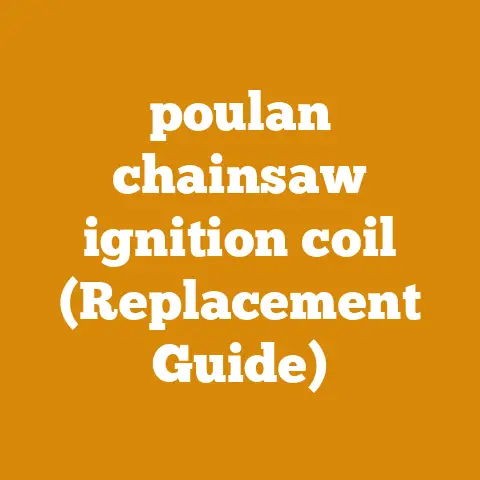Stihl Choke Symbol (3 Functions Explained)
Chainsaws are pretty much a staple for anyone involved in serious yard work, forestry, or even just maintaining a large property.
But have you ever stopped to think about those little symbols and levers on your chainsaw?
They might seem insignificant, but trust me, understanding them can save you a lot of time, money, and even headaches.
Today, let’s talk about the Stihl choke symbol—its functions, and how mastering it can make your life a whole lot easier.
So grab a cup of coffee, settle in, and let’s talk chainsaws!
Understanding the Stihl Choke Symbol
First things first: why does this matter?
Well, the choke is an integral part of starting your chainsaw.
Think of it as the key to unlocking smooth operation and effective fuel usage.
When I first started using chainsaws, I was baffled by these symbols.
I felt like I was deciphering hieroglyphics!
But once I got the hang of it, everything changed.
What is the Choke?
The choke is a small lever or button on your chainsaw that helps control the air-fuel mixture in the engine.
When you’re starting a cold engine, you need a richer fuel mix (more fuel, less air) to get things going.
The choke is what helps you achieve that balance.
Personal Story: My First Encounter with the Choke
I remember my first encounter with the choke on a chilly morning in late autumn.
I was out in the woods, trying to start my chainsaw for some firewood cutting.
I pulled the rope until my arms felt like noodles, but nothing happened.
A seasoned lumberjack walked by and asked if I had set the choke.
I had no idea what he was talking about!
After a quick tutorial, my saw roared to life.
It’s funny looking back now, but it was a real eye-opener!
Three Main Functions of the Stihl Choke Symbol
1. Starting a Cold Engine
Starting a cold engine can be a bit of a dance, but once you know the steps, it flows smoothly.
- Step 1: Locate the choke lever or button on your Stihl chainsaw.
It’s often represented by a symbol resembling a closed circle. - Step 2: Move the choke to the full choke position.
This enriches the mixture by reducing air intake. - Step 3: Pull the starter rope until you hear a pop sound.
This indicates that the engine has fired but hasn’t started running yet. - Step 4: Move the choke to the half-choke position and pull the starter rope again until the engine starts running smoothly.
Safety Warning: Always ensure your chainsaw is on stable ground when starting it to prevent accidents.
2. Warm Start
Once you’ve been using your chainsaw for a while and need to restart it, things change slightly.
- Step 1: Set the choke lever to the half-choke or open position.
A warm engine doesn’t require as much fuel enrichment. - Step 2: Pull the starter rope gently. The engine should start without much resistance.
Tip: If it doesn’t start immediately, resist the urge to rush!
Give it a moment before trying again.
3. Clearing a Flooded Engine
Flooding is common when too much choke is applied during start-up attempts.
It can be frustrating but manageable.
- Step 1: Move the choke lever to the open position to allow maximum airflow into the engine.
- Step 2: Pull the starter rope several times briskly to clear excess fuel from the combustion chamber.
- Step 3: Once cleared, follow your usual starting procedure.
Warning: Avoid continuous pulling as it could strain or damage the starter mechanism.
Prerequisites and Required Materials
Before you get started with any chainsaw work, it’s crucial to have:
- A basic understanding of how your chainsaw starts
- Safety gear: gloves, goggles, ear protection
- Stihl chainsaw manual (always handy)
- A clean workspace free of debris
Safety Precautions
Chainsaws are powerful tools that demand respect and caution:
- Always wear appropriate safety gear.
- Ensure the chainsaw is on stable ground during start-up.
- Familiarize yourself with emergency shut-off procedures.
Tips and Warnings Boxes
Tips:
- Regularly check your air filter and spark plugs to ensure they’re clean and functioning.
- Practice starting your chainsaw in different conditions to build confidence.
Warnings:
- Never operate a chainsaw without proper safety gear.
- Be cautious of kickback—know how to handle your saw if it occurs.
Common Questions
Why isn’t my chainsaw starting with the choke on?
There could be several reasons:
- Clogged Air Filter: Check if dirt or debris is blocking airflow.
- Old Fuel: Make sure you’re using fresh fuel.
- Spark Plug Issues: Examine for wear or damage.
Can I use full choke for a warm start?
Nope!
This can flood your engine with fuel.
Stick to half-choke or open positions for warm starts.
Troubleshooting Tips
If you’re encountering issues despite following these steps:
- Examine your spark plugs; they might need cleaning or replacement.
- Ensure you’re using fresh fuel; old fuel can lead to starting problems.
- Clean or replace air filters regularly for optimal performance.
Advanced Insights: The Science Behind Choking
Understanding why choking works can deepen your appreciation for this process:
- The choke reduces air intake, creating a richer fuel mixture that ignites more easily in cold conditions.
- Once warm, engines require more air for efficient combustion—hence moving to half-choke or open positions.
Personalized Storytelling: Learning Through Experience
Let me tell you about another experience that taught me about patience and understanding my tools better.
One summer morning, after spending hours felling trees on a friend’s property, I decided to take a break.
Returning from lunch, I couldn’t get my saw started again—it was a classic case of engine flooding from being overly eager with the choke earlier on.
After some trial and error (and maybe some colorful language), I finally cleared things up by removing excess fuel manually—a lesson learned through hands-on experience!
Final Reminders and Next Steps
Getting familiar with your saw’s choke settings is essential for efficient operation and longevity of your equipment:
- Practice these steps regularly until they become second nature.
- Keep safety gear accessible at all times.
- Consult professionals if unsure about any aspect of maintenance or operation.
FAQ Section
What’s the purpose of a choke on a chainsaw?
The choke enriches the fuel-air mixture to help start cold engines effectively.
How do I know if my engine is flooded?
If there’s a strong gasoline smell without starting success after several attempts—your engine might be flooded.
Is it okay to use my chainsaw without understanding these functions?
It’s risky—not only could you damage your equipment but also compromise safety by operating improperly.
By now you should feel more confident about handling those mysterious symbols on your Stihl chainsaw!
Remember practice makes perfect—and always prioritize safety above all else when working with such powerful tools like these beauties we call chainsaws!





